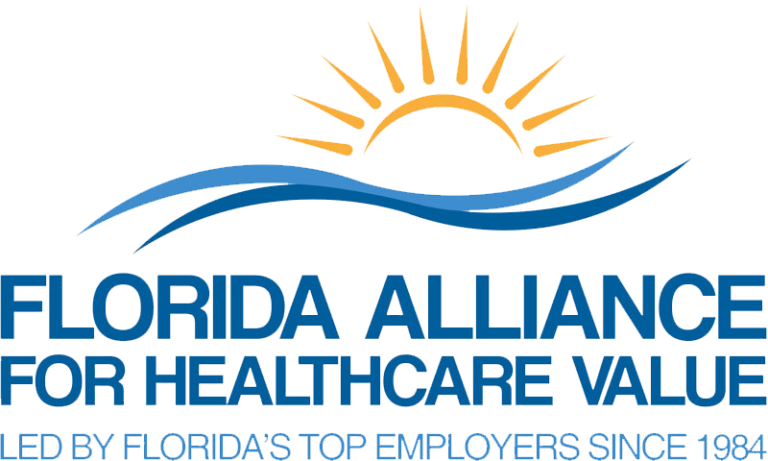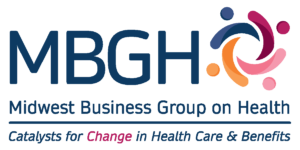
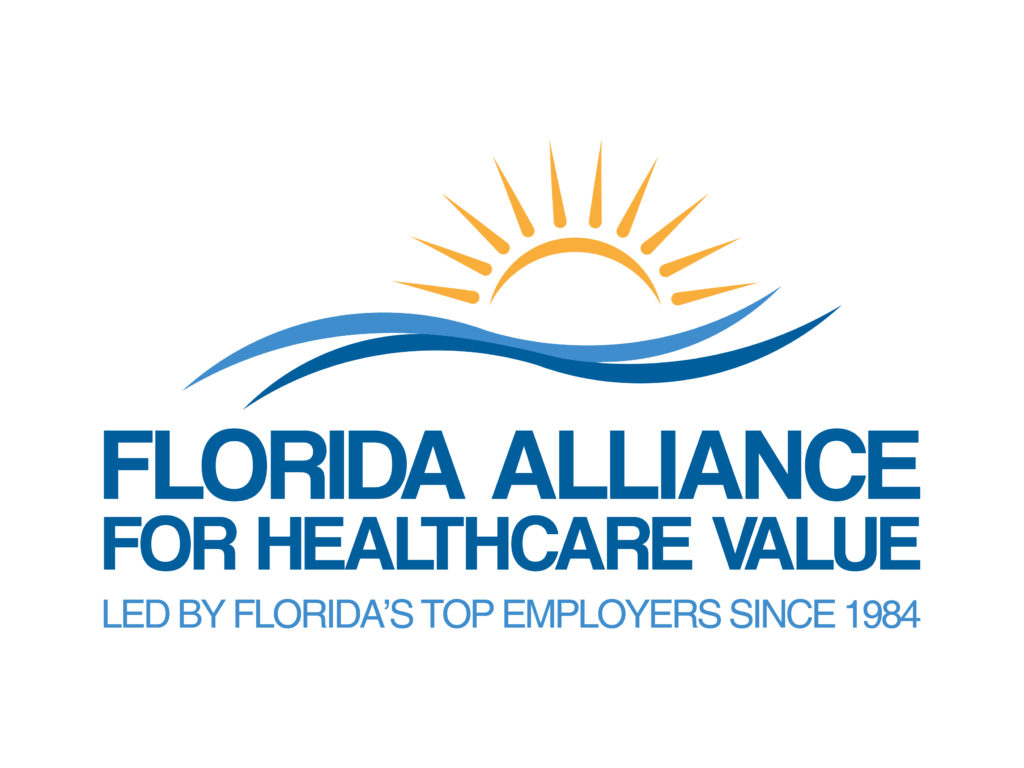
Oncology Learning Collaborative Partnership

Cancer prevention can reduce the incidence and severity of the disease, benefiting patients, their families, and employers.
Two important areas of cancer prevention are lifestyle choices and vaccines, including tobacco cessation, weight control, and obesity management. Another example is timely use of the human papillomavirus (HPV) vaccine, which can prevent several forms of cancer, including mouth, throat, anal and cervical cancer.
Healthy Eating and Active Living
The American Cancer Society Healthy Eating and Active Living Awareness Employer Toolkit is a practical resource designed to help organizations promote healthy lifestyle choices in the workplace. This toolkit provides employers with educational materials including fact sheets, posters, email templates, and social media content to encourage balanced nutrition and regular physical activity among employees. It highlights the connection between lifestyle behaviors and reduced cancer risk, while offering tips on incorporating healthier habits into daily routines, such as making better food choices, staying physically active, and reducing sedentary time. The toolkit also includes ideas for wellness challenges and programs that foster a culture of health and well-being. By utilizing this resource, employers can support disease prevention, boost employee morale, and enhance overall productivity through improved physical health.
Tobacco Cessation
Nationally, about 12% of adults aged 18 years or older smoke cigarettes. Tobacco smoke is a toxic mix of more than 7,000 chemicals, with at least 70 known to cause cancer in people and animals. People who smoke cigarettes are 15 to 30 times more likely to get lung cancer or die from lung cancer than people who do not smoke.
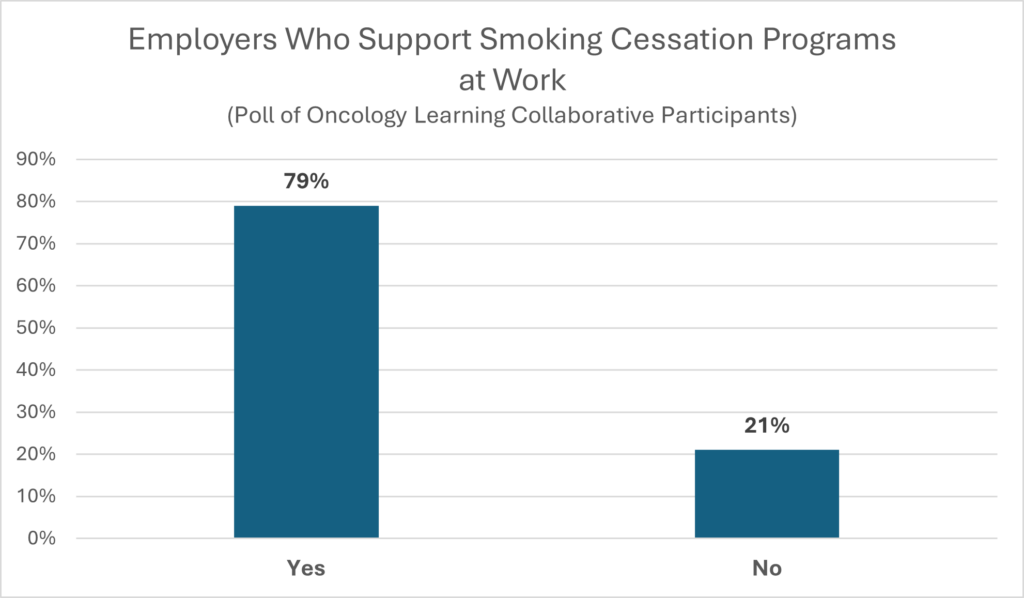
In a poll, nearly 80% of employers who participated in the OLC currently support smoking cessation programs at work.
Carole Mendoza, VP of Benefits, Voya Financial
“We charge a smoker surcharge. If the smoker participates in a cessation program, they do not pay the surcharge. A recent audit found our employees are being honest and we are reducing use with current rates about 4%.”
Sherri Samuels-Fuerst, VP of Total Rewards, Sargento Foods
“We offer a level-one premium credit to non-tobacco users and a level-two premium credit if they are a non-tobacco user and are within a certain BMI range. If employees do not qualify for a credit, they can qualify by completing certain activities, such as meeting with their PCP, participating in a tobacco cessation class or program, working with the health coach, dietitian and/or personal trainer in the on-site Health and Wellness Center, etc.”
Kenneth Aldridge, Director of Health Services, Rosen Hotels and Resorts
“In 2007, we moved to a no-smoking, no-tobacco policy. It was not a no-tobacco-use-on-campus policy; it was a non-use of any tobacco products anywhere policy.”
Obesity and Weight Control
During the OLC, it was recommended that the Employer Members make obesity management part of their oncology management strategy. Obesity is associated with increased risk of colorectal, uterine, breast, kidney, and gallbladder cancer. About 4%-8% of all cancers are attributed to obesity. MBGH created an Obesity Management Toolkit (see resources below) focused on the obesity management continuum, which starts with prevention and wellness, then lifestyle management and/or disease management (i.e., coaching and behavioral support), as well as recognizing the role of anti-obesity medications (AOMs) on the market, including GLP-1s.
Points to consider:
- As part of obesity management, addressing weight, lifestyle, and co-occurring conditions is key.
- Pharmacotherapy (AOMs and GLP-1s), along with lifestyle modification, can yield outcomes of 5% to 10% for traditional AOMs and significantly more for GLP1s, especially for people with one or more co-occurring conditions.
- Bariatric surgery and gastric sleeve procedures can offer outcomes that are significant (20%-30% weight loss).
- Recently BMI (body mass index), which is based on the height and weight of a person, is seen as an inaccurate measure of body fat content and does not take into account muscle mass, bone density, overall body composition, and racial and gender differences, say researchers from the Perelman School of Medicine, University of Pennsylvania. A new study suggest waist-to-hip measurements are more accurate predictors.
- One of the challenges employers faces as they learn more about GLP1s is that they are intended to be taken for a lifetime to maintain efficacy, which is costly and comes with patient adherence challenges. Scientists are conducting studies now to determine if GLP-1s are “forever drugs.”
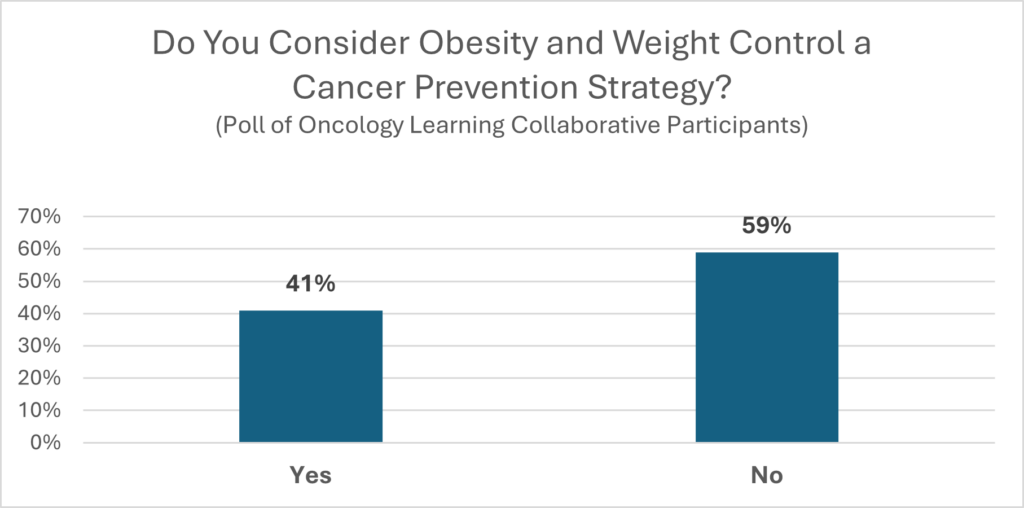
Only 41% of the Employers who participated in the OLC say they have thought about an obesity strategy in the context of cancer prevention.
About half of MBGH’s Employer Members indicated in a previous survey that they are waiting for more evidence before paying for the medications, while the other half (which tends to be large employers), are viewing obesity as a chronic disease and are covering them.
Sherri Samuels-Fuerst, VP of Total Rewards, Sargento Foods
“We focus on obesity and try to focus on weight-loss strategies to reduce all co-occurring conditions.”
Rosa Novo, Administrative Benefits Director at Miami-Dade County Public Schools
“We are looking at adding coverage for the anti-obesity medications and just reintroduced coverage for all weight-loss surgeries last year.”
Susan McBroom, Director of Human Resources, Patriot Rail Company
“We have a population that has lost a significant amount of weight on GLP-1s in a very short period and now they are struggling with their excessive skin and unable to afford aesthetic services.”
Human Papillomavirus (HPV) Vaccine
Human papillomavirus (HPV) is estimated to cause nearly 36,400 cases of cervical cancer in the US every year. It can also cause other cancers like mouth, throat, and anal cancer. Most HPV infections go away on their own, but those that do not can cause cancer. The HPV vaccine, which is close to 100% effective, treats six types of cancer and could prevent more than 90% of related cancers.
Uptake of the HPV vaccine is low. In 2022, only 38.6% of children ages 9–17 years had received one or more HPV vaccine doses.
Education is key to removing barriers to HPV vaccinations. For example, some parents incorrectly believe teens will become more promiscuous if they have the vaccine. The American Sexual Health Association offers these myths and facts about HPV.
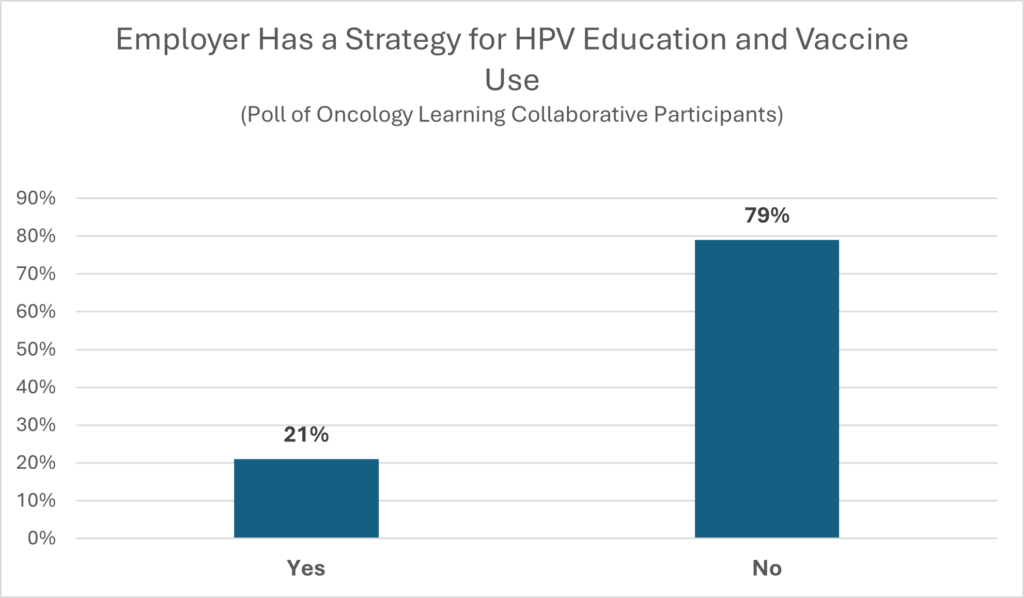
Only 21% of employers who participated in the OLC say they have a strategy for HPV education and vaccine use. Most of the participants indicated that HPV vaccination is included in their overall vaccination strategy. Much like the recommendation to incorporate obesity management and weight control into an oncology management strategy, it was recommended that increased uptake of the HPV vaccine become a part of their oncology strategy.
Source: HPV Cancer Prevention Program
Sherri Samuels-Fuerst, VP of Total Rewards, Sargento Foods
“The HPV vaccine is available at our on-site health and wellness center, and we encourage people to follow the full vaccination schedule based on age and gender. One of the missing links is making consumer or patient information widely available. It is probably the best thing an employer can do because the information is not available from other sources.”
Susan McBroom, Director of Human Resources, Patriot Rail Company
“We have just started to take a deeper dive into our data to determine our HPV vaccination rates. We have also started to highlight it more in our preventive campaigns. Our vendor partners and navigators send postcards to homes, and we circulate e-postcards in specific months, highlighting the importance and availability of screenings and immunizations. “
FL HPV-Related Cancers and HPV Vaccination Rates Resource
HPV Adolescent Fact Sheet
HPV Vaccination – Implementation Guide for Employers
CDC Recommendations for HPV Vaccinations
HPV – It’s About Cancer
Adult Disease Awareness
HPV and Head and Neck Cancers: Do you know the facts?
Human Papillomavirus Vaccination Coverage in Children Ages 9–17 Years: United States, 2022
Communicating Cancer-Related Resources and Benefits
OLC participants are using a variety of communication channels to reach employees and their families. Given literacy, health literacy, unique preferences for obtaining information and other challenges, a comprehensive communications strategy and plan designed to drive engagement and action is essential.
Sherri Samuels-Fuerst, VP of Total Rewards, Sargento Foods
“We have our on-site health and wellness centers which are always promoting and providing education. We do a vendor summit where we bring our 17 to 20 vendors together every year to educate the vendors on all our services so they can support and provide navigation services through the different benefits for the individuals to maximize their benefits. It is not 100% effective, but it does move in the right direction.”
Rosa Novo, Administrative Benefits Director at Miami-Dade County Public Schools
“We are working on our own cancer support materials, and we see a disconnect between what the health plan and what we put out. For instance, the health plan will not share any information about how to utilize the accelerated payments of the life insurance plan, so we must do it. We also like it when employees give testimonials that we can add to our materials.
We make sure all our employees have access to all our benefits offered outside of our health plan. We utilize all our personnel including employees in human resources, those in benefits, payroll, leaves, disability, and recruitment.”
Dan Dentzer, Manager of Health and Welfare Strategy, United Airlines
“We have found employee testimonials to be incredibly effective, as well as a great way to promote programs. We recognize that people often don’t read emails, so we use our intranet site and put video testimonials on it. The employees talk about the care and treatment they received through one of our programs and the other employees listen to them. We also sponsored Cancer Day Webinars where a trio of employees told their stories. These are very effective and not just from a cancer perspective, but also when we dial in social determinants of health or diversity, equity, inclusion (DEI) initiatives.”
Sherri Samuels-Fuerst, VP of Total Rewards, Sargento Foods
“We do a comprehensive campaign around cancer and prevention in general. On our employee portal, we did a campaign around oral cancer in April and prevention screening awareness in January. We also did campaigns around breast and colon cancer. We tried to tie our oral cancer campaign to our Delta Dental benefits.
We have articles on our employee portal (and post things on the electronic bulletin boards, posters with QR codes in the lunchrooms, etc.) highlighting the benefits and resources. We tend to combine our campaigns around other national cancer awareness months and/or other events (like Father’s Day, etc.). Our communications team does an excellent job working with us to help promote all of our programs, services and benefits throughout the year.
We bring this information to our people in the plants. They have two paid 15-minute breaks and don’t often go to the employee portal, called “The Block,” unless it is annual enrollment. We do table tents with QR codes, messages on the TVs in the lunchroom, and electronic bulletin boards.”
© Copyright 2024 Central Florida Health Care Coalition, Incorporated d/b/a Florida Alliance for Healthcare Value
The Central Florida Health Care Coalition, Incorporated d/b/a Florida Alliance for Healthcare Value is providing this information to our employer members solely in our capacity as a 501c3 nonprofit education organization and not as advice in any capacity. The information that is not in the public domain is private and confidential.
